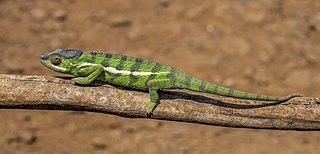Related Research Articles

Gehyra mutilata, also known commonly as the common four-clawed gecko, Pacific gecko, stump-toed gecko, sugar gecko in Indonesia, tender-skinned house gecko, and butiki in Filipino, is a species of lizard in the family Gekkonidae. The species is native to Southeast Asia. It has made its way to several areas of the world including Sri Lanka, Indochina, and many of the Pacific Islands. Compared to the common house gecko, the appearance of G. mutilata is somewhat plump, with delicate skin. The skin is usually colored a soft purplish/pinkish gray, with golden spots on younger specimens; these spots eventually fade with age.

The wildlife of Réunion is composed of its flora, fauna and fungi. Being a small island, it only has nine native species of mammals, but ninety-one species of birds.

A pheromone trap is a type of insect trap that uses pheromones to lure insects. Sex pheromones and aggregating pheromones are the most common types used. A pheromone-impregnated lure, as the red rubber septa in the picture, is encased in a conventional trap such as a bottle trap, Delta trap, water-pan trap, or funnel trap. Pheromone traps are used both to count insect populations by sampling, and to trap pests such as clothes moths to destroy them.

Xylosandrus compactus is a species of ambrosia beetle. Common names for this beetle include black twig borer, black coffee borer, black coffee twig borer and tea stem borer. The adult beetle is dark brown or black and inconspicuous; it bores into a twig of a host plant and lays its eggs, and the larvae create further tunnels through the plant tissues. These beetles are agricultural pests that damage the shoots of such crops as coffee, tea, cocoa and avocado.
References
[4] [1] [8] [13] [18] [21] [23] [30] [39]
- 1 2 3 4 5 6 7 "NAS - Nonindigenous Aquatic Species". U.S. Geological Survey. 20 June 2016. Retrieved 6 December 2016.
- ↑ "Adoretus sinicus (Chinese rose beetle)". www.cabi.org.
- ↑ "Aleurotrachelus atratus (palm-infesting whitefly)". www.cabi.org.
- 1 2 "Aphis spiraecola (Spirea aphid)".
- 1 2 3 4 Messing, Russell (September 1999). "Managing Fruit Flies on Farms in Hawaii" (PDF). College of Tropical Agriculture and Human Resources. University of Hawaii. Retrieved 3 December 2016.
- ↑ "Cactoblastis cactorum (cactus moth)". www.cabi.org.
- ↑ "Callinectes sapidus (blue crab)". www.cabi.org.
- 1 2 "Cerataphis lataniae (Palm aphid)".
- ↑ "Chilo suppressalis (striped rice stem borer)". www.cabi.org.
- ↑ "Chthamalus proteus". www.cabi.org.
- ↑ "Cryptotermes brevis (powderpost termite)". www.cabi.org.
- ↑ "Culex quinquefasciatus (southern house mosquito)". www.cabi.org.
- 1 2 "Drosophila suzukii (spotted wing drosophila)". www.cabi.org.
- ↑ "Elatobium abietinum (green spruce aphid)". www.cabi.org.
- ↑ "Epiphyas postvittana (light brown apple moth)". www.cabi.org.
- ↑ "Euwallacea fornicatus (tea shot-hole borer)". www.cabi.org.
- ↑ "Exomala orientalis (oriental beetle)". www.cabi.org.
- 1 2 "Frankliniella occidentalis (western flower thrips)". www.cabi.org.
- ↑ "Glycaspis brimblecombei (red gum lerp psyllid)". www.cabi.org.
- ↑ "Homarus americanus (American lobster)". www.cabi.org.
- 1 2 "Hypogeococcus pungens (cactus mealybug)". www.cabi.org.
- ↑ "Litopenaeus vannamei (whiteleg shrimp)". www.cabi.org.
- 1 2 "Maconellicoccus hirsutus (pink hibiscus mealybug)". www.cabi.org.
- ↑ "Mythimna unipuncta (rice armyworm)". www.cabi.org.
- ↑ "Neolecanium cornuparvum (magnolia scale)". www.cabi.org.
- ↑ "Nesticella mogera (cave-dwelling spider)". www.cabi.org.
- ↑ "Opogona sacchari (banana moth)". www.cabi.org.
- ↑ Dowd, Eddie (January 12, 2023). "Task force: State has lost battle to eradicate coconut rhinoceros beetle on Oahu". Hawaii News Now. Retrieved 2023-01-16.
- ↑ "Paratrechina longicornis (crazy ant)". www.cabi.org.
- 1 2 "Pineus pini (Pine woolly aphid)".
- ↑ "Procambarus clarkii (red swamp crayfish)". www.cabi.org.
- ↑ "Pseudaulacaspis pentagona (mulberry scale)". www.cabi.org.
- ↑ "Pseudococcus viburni (obscure mealybug)". www.cabi.org.
- ↑ "Sepedomerus macropus (liverfluke snail predator fly)". www.cabi.org.
- ↑ "Sepedon aenescens (snail-killing fly)". www.cabi.org.
- ↑ "Solenopsis papuana (Papuan thief ant)". www.cabi.org.
- ↑ "GISD". www.iucngisd.org.
- ↑ "Sophonia orientalis (two-spotted leafhopper)". www.cabi.org.
- 1 2 "Xyleborinus saxesenii (fruit-tree pinhole borer)". www.cabi.org.
- ↑ "Xylosandrus crassiusculus (Asian ambrosia beetle)". www.cabi.org.
- ↑ "Xylosandrus germanus (black timber bark beetle)". www.cabi.org.
- ↑ "Xylosandrus morigerus (brown twig beetle)". www.cabi.org.
- ↑ "Ovis aries musimon (European mouflon)". www.cabi.org.
- ↑ Suzuki‐Ohno, Y.; Morita, K.; Nagata, N.; Mori, H.; Abe, S.; Makino, T.; Kawata, M. (2017). "Factors restricting the range expansion of the invasive green anole Anolis carolinensis on Okinawa Island, Japan". Ecology and Evolution. 7 (12): 4357–4366. doi:10.1002/ece3.3002. PMC 5478079 . PMID 28649347.
- 1 2 3 Fisher, Robert N. (1997). "Dispersal and evolution of the Pacific Basin Gekkonid Lizards Gehyra Oceanica and Gehyra mutilata" (PDF). Evolution. 51 (3): 906–921. doi:10.1111/j.1558-5646.1997.tb03672.x. PMID 28568588. S2CID 28894843.
- ↑ "Hemidactylus frenatus (common house gecko)". www.cabi.org.
- ↑ Fisher, Robert; Ineich, Ivan (April 20, 2012). "Cryptic extinction of a common Pacific lizard Emoia impar (Squamata, Scincidae) from the Hawaiian Islands". Oryx. 46 (2): 187–195. doi:10.1017/S0030605310001778. S2CID 86545634 – via Cambridge Core.
- ↑ "Lepidodactylus lugubris". The Reptile Database.
- ↑ "Herping In Hawaii". www.reptilesmagazine.com. 9 July 2013.
- ↑ "IUCN Red List of Threatened Species: Phelsuma laticauda". IUCN Red List of Threatened Species. January 27, 2011.
- ↑ "IUCN Red List of Threatened Species: Wattle-necked Softshell Turtle". IUCN Red List of Threatened Species. June 30, 2000.
- ↑ "Wattle-necked Softshell (Palea steindachneri) - Species Profile". nas.er.usgs.gov.
- ↑ "IUCN Red List of Threatened Species: Chinese Softshell Turtle". IUCN Red List of Threatened Species. June 30, 2000.
- ↑ "Chinese softshell (Pelodiscus sinensis) - Species Profile". nas.er.usgs.gov.
- ↑ "Trachemys scripta elegans (red-eared slider)". www.cabi.org.